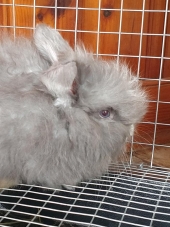





I will definitely post more pictures! I'm located in central Virginia, but I do travel to shows along the east coast from New York to Florida, and as far west as Ohio and Louisiana, depending on how well I'm doing that particular show season :). I do have some great lines and I've been developing my BEW and Vienna lines to improve type, wool density, and ear carriage. I actually have a BEW doe who reached GC status!!! She is my greatest success, lol. This is her granddaughter. If you really are interested, send me a message and we can share emails :)Alexis Richard wrote:
Amanda Parker wrote:
Alexis Richard wrote:Not that I'm an expert by any stretch of the imagination... but I did breed rabbits for about 6 years. So I feel like my opinion probably has at least a little logic behind it rofl.
I would go with Chocolate Pearl like those breeders said simply because she has too many decidedly brown hairs in there for me to consider her a lilac. And to me, she really is a little dark to be a pure lilac. Grey Pearl wouldn't fit because of the brown. I'd almost want to say she's ticked. But it's so subtle I'm honestly not sure I'd go that far.
Whatever she is, she is absolutely beautiful, and I think breeding for more with her coat would be very successful. Now you've really got me wanting to start on Angoras darn it.... But only if I can have this doe to start my herd lol.
If she lightens a little bit more I'd probably call her a Chocolate Pearl Ticked if she were mine.
Well if you're really interested.....lol I have no plans to sell her but I do have a chocolate agouti who carries chd that I plan on breeding her with so if she's a chocolate pearl I should get a few more out of the crossing. I am really leaning toward chocolate pearl too, she looks almost blue in some light, but in sunlight you can really see the brown in her coat, it's almost a taupe. I want to say she's ticked too....which almost makes me think of steel, but she doesn't have any Es in her pedigree that I can find. I did some searching and I also found something called a "snowball", which is when the undercoat of their first coat is white or super pale below a ring of color. It happens most often in self rabbits, but can happen in almost any color. Her new coat has just started down at the skin so I'm waiting to see what her Jr coat looks like before I make a final decision, but I feel most people have been leaning toward chocolate pearl. Thank you so much for your response!
Oh no... where are you located? Because now I'm INTERESTED.
I see what you mean about the taupe. It's such a cool tone brown.... if I were painting her she would definitely be an umber brown, not a sienna! Most chocs I've seen are so reddish. I've rarely seen such a cool tone brown.
I honestly can't wait to see her full Jr coat! Please post another pic when she's got it all out!! <3

Alexis Richard wrote:Not that I'm an expert by any stretch of the imagination... but I did breed rabbits for about 6 years. So I feel like my opinion probably has at least a little logic behind it rofl.
I would go with Chocolate Pearl like those breeders said simply because she has too many decidedly brown hairs in there for me to consider her a lilac. And to me, she really is a little dark to be a pure lilac. Grey Pearl wouldn't fit because of the brown. I'd almost want to say she's ticked. But it's so subtle I'm honestly not sure I'd go that far.
Whatever she is, she is absolutely beautiful, and I think breeding for more with her coat would be very successful. Now you've really got me wanting to start on Angoras darn it.... But only if I can have this doe to start my herd lol.
If she lightens a little bit more I'd probably call her a Chocolate Pearl Ticked if she were mine.

Juniper Zen wrote:I'm a newbie when it comes to rabbits, but I've always had good luck getting my color questions answered on the Rabbit Talk forums. They have a whole subforum dedicated to colors.
My understanding is that the white base means there must be chinchilla, and that color does like lilac. So my guess would be self lilac chinchilla, which is what you mean by chocolate pearl, I think? But again I'm new to this.
I will be watching this thread for answers!
